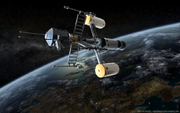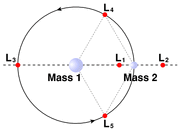The United Nations of Earth is the official title of Earth's governing body in the 23rd Century. In fact, Earth is a bit of a misnomer - over the centuries "Earth" has come to mean all of the area inhabited by those descended from the original blue marble in the unfashionable Orion Spur of the western spiral arm of the Milky Way galaxy.
Before the events of the Aetus Tumultus, Earthen civilizations were fractured into many diverse nations, many of whom rarely saw eye-to-eye on any number of issues. Earth is now a system of colonies under seven Prime Colonies who themselves are under the homeworld and Capitol of Sôl. Since that time, the idea of mere sovereign nations acting together has faded; any sense of nationalism now exists between the colonies. The title of The United Nations of Earth is still used in formal dealings, though, including in the memorabilia if cultural centers of all colony worlds, which is perhaps how the the Tarsins of the Coalition first learned of them.
For only just over a century, Earth has been a fledgeling spark of peace, diversity, and beneficial technological progress in what they are just learning is a muck of stagnant races and remnant echos of the past that make up the World they live in. Recent events have allowed fascist rule to creep in, however. But despite constant guerrilla assaults from any number of radical pirate groups, rumors of rogue death machines from dead and gone civilizations from long ago, and forty years of war with the Arkanin; Earth is still young and limber for whatever the depths of space have to throw at it. The resolve of the Earthen, as some call themselves, is mighty and their ability to adapt and advance is impeccable; they are a wildcard that will change the game forever, as Tarsis has only just begun to realize.
Histroy[]
Main Article: History of Earth
[being written]
Organization[]
Main Article: Earth Government
[being written]
See also[]
- Earth Colonies
- Aetus Tumultus
- Tachyon Bubble Drive
- Standard Colonization Practice
- Xenoarchaeology
- Notable Individuals
More to come!
The following is old and needs to be moved. Bear with us. :'^(
Formation and Early Years[]
Commonly referred to as the UNE, the United Nations of Earth took shape in the 22nd century after the passing of radical legislation to institute a global level of supreme government. As individual countries often acted out of self-interest, the idea was that incurring legal penalties as opposed to the previous warnings and finger-waving would hold more sway with leaders and keep the world off of that third world war everyone thought was coming for the past 200 years. In order to reinforce the power held by the new Global Assembly, all countries were ordered to essentially disarm their entire respective military. Just in case anyone got any funny ideas, a rapid-deployment, hard-hitting peacemaking force was established with the ability to clean up any insurgency across the globe withing a matter of hours. Though Earth did not know it at the time, such military development would prove invaluable in the near future.
Despite this, the world was still in relative turmoil for those unfortunate enough to live in third world countries. The heavy legislation, though surprisingly effective in practice, was often not instituted until after an uncooperative nation had acted out, not to mention the more prosperous countries still made attempts to strong arm the others. While history books still disagree as to the ease of this new world government, any cultural tension shared between national origins had mostly dissolved by the twenty-third century. The Professor of Contemporary History at the Interstellar University of Sagan, Suriyothai L. Kuznetsov, would remark the following in her patriotic, if not downright controversial, book Accidental Intention- The New Colonial Era:
"No one's really sure [how the UNE was created]- but gee whiz, I'll bet the fear of being nuked at a moment's notice was ubiquitous! ... When Tachyon Bubbles became a thing, people could finally escape the zomgy, second-cold-war setting of Earth in search of a new patch of land in some far-flung system in which to call their own, creating an unprecedented era of advancement and creativity."
However, the issue of how a unified world could not only exist, but spread and prosper as fast as it did still remains a controversial subject to some and a conundrum to most; but one thing is known- Earth is the miracle.
Faster Than Fast Itself[]
As the bureaucracy sorted itself out, space industry also steamed along like never before. What money that had formerly gone to fund the now dissolved militaries that had not been diverted to welfare and food production was channeled in to space exploration and the expansion of Humanity's interstellar footprint. It is thought that NASA merged with the ESA to form what historical records call the "Western Space Administration," their powers combined to spur development of more orbital stations and soon a small Lunar mining colony.

A Cecil Rhodes-Class Colony Ship, which began production in the 2230s.
However, the most influential invention of the century-millennium, even; was without a doubt the Tachyon Bubble Drive, a method of faster-than-light travel that basically boils down to using a field dense enough to exempt any mass found inside from the usual cosmic speed limit of 3x10^8 m/s, the speed of light. Now armed with the ability to cross vast distances in relatively little time and using only a fraction of the previous energy requirements, the floodgates for inter-solar expansion and colonization was finally possible. Within 50 years, large settlements of humanity could be found in almost a dozen star systems. Of these a few systems are of note, though there are still others that are also important yet remain unmentioned here; such as the "consumer-capital" of Sirius, the fertile and farm-rich country side of No-Murassa IX, the scattered oasis of Epsilon Erandi, Cimmeria, Oshara, and others. It seemed Mankind was to have a glorious future of peace among the stars.
But as they say, all good things must come to an end...
The Piracy Crisis[]

Wright Class Patrol Vessel
The first true weaponization of space was not, as so many had predicted, the work of any national government. Instead, and-once permanent colonies and legitimate supply lines to the new worlds had been established-a rogue band of freighters decided they would be better served raiding and looting other cargo-hauling vessels rather than toiling their excavators through mines, like those found on planets within 5298 Tarandi, to earn an honest living. Others would follow suit; and, before long, whole organized cartels had formed.
As the problem grew more severe, the Earth Government commissioned several engineering companies to design and construct the first class of space warships, in order to pacify the pirate threat. The Wright class was among these first generation of vessels and saw service in several conflicts before the growing pirate fleets began to develop warships of their own.
Yet, when additional pirate threats began to spring up in the far reaches of space, companies were allowed to sell warships to system militias for the purpose of defense. However, due to the government's fear of these vessels making their way into pirate hands, a more organized stellar navy, of sorts, was devised through the immediate liquidation of militias, most of which found there way into this new navy anyways. Why stellar engineering companies did not behave more towards their self interest- which is to say, why they didn't sell to both pirates and militias to rake in profits- is another unclear aspect of history. Some believe that the companies preferred a more stable shipping industry as that was the means for them to acquire their raw materials, yet others will attest to the idea that the majority of Earthmen dreaded anything of resemblance to the political tension experienced just prior to the colonial age.
Earth: The Planet Orbiting SÔL[]
("System of Sôl" redirects here.)[]
“Oh-boy-oh-boy, this is the part where people 100 years from now will laugh at me!” ~Moffatt
The population of the planet itself, by the time the UNE was mid-way through the Othaen War of the 2250’s; if nothing else, was starting to get a little crowded. Colonial influx of off-planet grains and other necessities allowed for sweeping urbanization across previously agrarian landscapes. Cities continued to build up and out- as well as down in some instances; notably across Russia, North America, and surprisingly enough, the equator. Other areas simply ceased to expand past a certain limit as inhabitants left for a life among the colonies that became ever more prosperous. It should be noted that the concept of 'nations' as the United Nations of Earth's title implies, had all but completely dissolved in the political sense, though regions still bear their ancestral names. Heritage is still existent, though; however, ethnic pride has become just short of an oddity among the middle and upper class, as bloodlines have blended somewhat evenly. It could be better said that the proper title for this civilization of humans is "the United Nation of Earth," yet the plural form of nation continues to appear on official government records.
On the topic of population, Earth proper was home to roughly eighteen billion residents before the war got ever more serious with Tarsin involvement. Many live in densely populated slums and favelas, others in modern metropolises and sprawling high-rise suburbs. Few continue to live an agricultural lifestyle as most farming is done off-world. This separation of lifestyle is hardly by decree, however, as few planetary regulations in regards to urban planning were put into place, allowing both the roses and the thorns of free market enterprise to take its course. As a result, of course, certain areas are a cesspool of crime and pollution whereas others are pristine and lovely. One government regulation that does exist, however, was implemented in the 2210s, imposing a hefty fine on any further outward expansion of urban populations in order to encourage the more space-efficient vertical high rise/skyscraper variety of development. This achieved its desired effect, which was to halt the development of natural environments into single story space-wasters; as a result, beautifully tall facades of structural-plastic and glass juxtaposed equally serine landscapes at best while slummy towers leaned over wilderness plagued with chemical run-off and devious packs of children at worst.

A view of Earth just after sunset.
Despite crowded conditions in many parts of the planet, the overall standard-of-living is high compared to the 200 years previous. Lasers can zap what medicinal drugs can’t fix and basic health care is guaranteed as a universal right to those who can prove their residency in triplicate, as freeloading colonials aren't unheard of. Stem cell research has progressed to the point where growing replacement tissue is commonplace- though expensive- and fully-pregrown limbs are available on the market for those rich enough to pay for on-demand backups. A more economical alternative exists, however; mechanical prosthetics offer a cheaper solution devoid of growth-delay or the body's rejection. Some higher-end models even have an anatomical resemblance to real limbs and even basic "nerve" sensors. A sect of electronic enthusiasts located in populated settings, however, have grown a liking toward the less pleasant-to-look-at mass of glass-steel and motors that make up these mechanical add-ons. Public opinion of the minority group’s often self-imposed, thuggish lifestyle is generally uneasy, and those with extensive non-cosmetic mechanical limbs are derogatorily labeled as “Tim-Men.” Also, less monetarily gifted farm technicians living on agricultural worlds often prefer the non-cosmetically appealing models due to their higher cost of maintenance, though these individuals often are not usually associated with "Tin-Men." It should be noted that the state of healthcare-technology that is mentioned here is relatively consistent throughout the UNE and is not just exclusive to the planet of Earth. Flying cars, however, still don’t fill the skies because- let’s face it- it’s a terrible idea.
For the moment, at least, the introduction of massive air scrubbing facilities around the globe combined with switches to renewable and fusion energy have put a halt to excessive pollution that was leading to a higher overall temperature fluctuation. That does not mean the Earth is restored to its pre-twenty-first century climate, but for the moment things do not seem to be getting any worse and in some cities one can once again spot a star or two in the night sky! (It should be noted that stares are still very much a thing in the night skies of larger wildlife preserves and natural parks, though few of the overall population bother to spend their time in those places.) Overblown storm fronts are often still an issue for coastal regions, however. No one is quite sure if things will return to as they were in the "good old days," though hope exists that it is still possible, given enough time.
Earth: The Moon[]
Earth’s moon was the first body on which a permanent base was established, simply for the logistical reasoning of “it’s right there, we may as well.” Despite the early colonization, the population of lunar bases remains quite small since the moon is really nothing more than a big, dusty rock sitting in the harsh vacuum of space. Several mining bases across the surface house no more than a million permanent residents, with other areas set up as historical sites with a few tourist locations. Notably, the Lagrange Construction Facility is locked in a stable orbit between Earth and the Moon and is mentioned below.
Earth: Notable Satellites

Lagrange points for a 2 mass system
Lagrange Construction Facility[]
- The LCF is a large space station locked in orbit between Earth and the moon at the L1 Lagrange point. The simplest way to explain this orbit is that it's at a distance where the moon's gravity cancels out Earth's, holding it in place.
- This is the birthplace of the first deep-space vessels and has undergone numerous retrofittings over the course of the UNE's colonial period. Raw material was at one point shipped here for processing, refining, and eventually the manufacturing of space-worthy vessels. These "mats," as they're called, came from mining operations conducted on the surface of the moon as well as from asteroid belts back in the very first days of Earth's venture into space. Later, the materials would come from locations outside the system, and as more of these construction sites came about, the less the LCF was used. While it is still operational today, the creation of even larger construction facilities elsewhere in the colonies had rendered it inferior, though it is still used as a space station, research facility, and museum.
